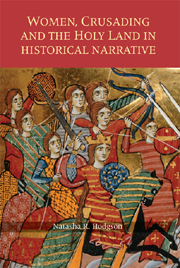Introduction
Published online by Cambridge University Press: 12 September 2012
Summary
IN the spring of 1188, Gerald of Wales accompanied Archbishop Baldwin of Canterbury on a preaching tour to promote the Third Crusade. At Abergavenny, Baldwin encountered a nobleman called Arthenus, who, wavering over his decision to take the cross, wished to consult his friends first. The archbishop asked if he wanted the guidance of his wife as well. Arthenus, shamed, took up the cross immediately, saying: ‘This is man's work we are undertaking, the advice of a woman is not required.’
The perception of crusading as ‘man's work’ has lingered in historical tradition. Throughout successive generations of scholarly interest, the crusades have stayed firmly entrenched within the confines of military and religious history – areas that were dominated by men for the majority of recorded memory. Later historians were largely content to emulate their medieval counterparts by giving negligible attention to the role that women played in the crusade movement. In the second half of the twentieth century, however, scholarship began to shift away from the military exploits of crusaders and the politics of Holy War to an increasingly panoramic view of the impact that crusading had on medieval society. This has paved the way for new studies about the roles played by women on specific crusades, and those who lived in settler societies of the Latin East, Iberia or the Baltic. Riley-Smith has established the importance of certain noblewomen in recruitment and finance for the early crusades, and has explored the impact that these expeditions had on their lives.
- Type
- Chapter
- Information
- Publisher: Boydell & BrewerPrint publication year: 2007



